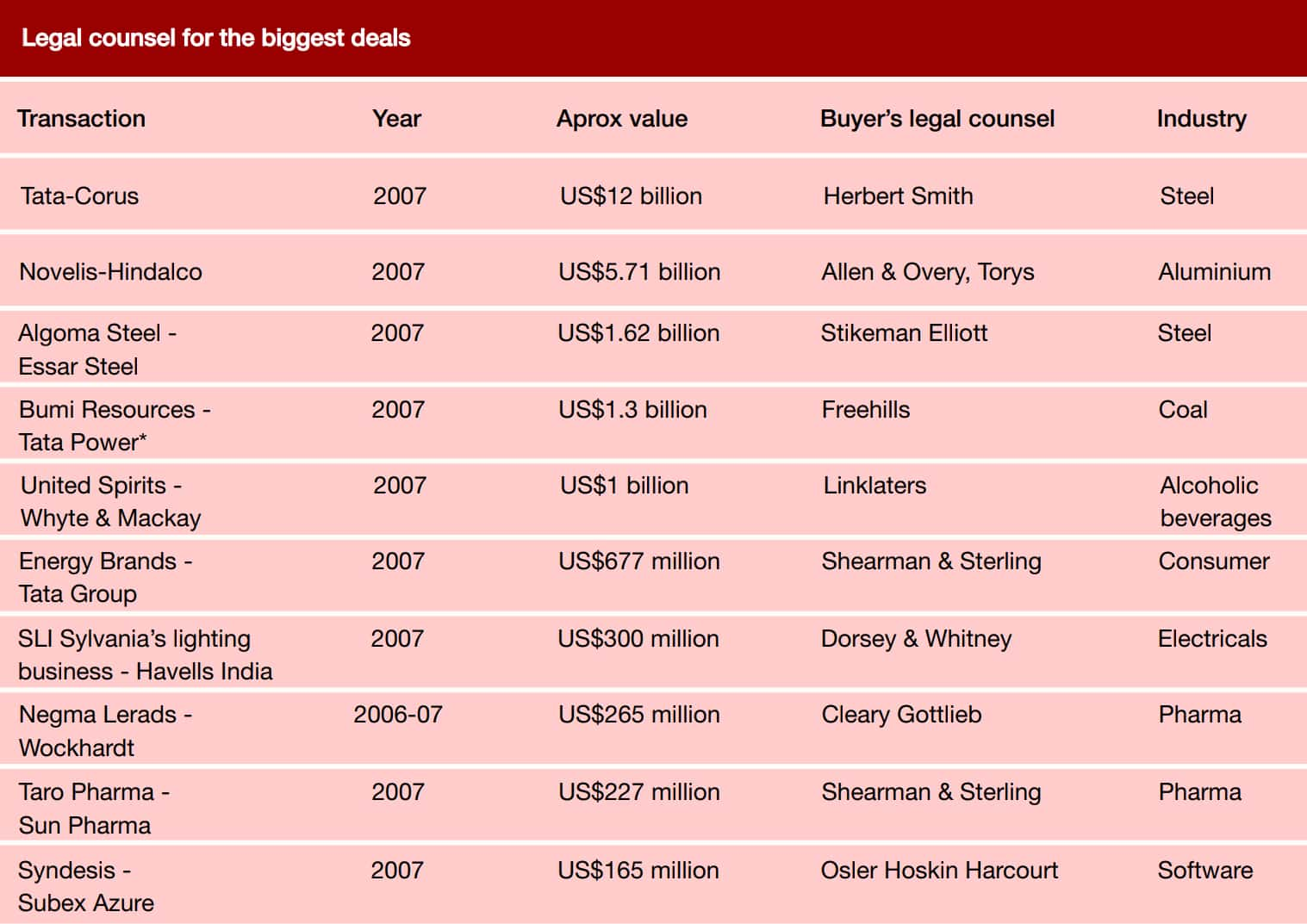India Inc has embarked on a global shopping spree, but is it equipped to tackle the legal and regulatory hurdles it will face?
Ed Lane reports from New Delhi
Between 2002 and the first half of 2006, corporate India paid about US$5.5 billion to acquire 101 overseas companies, largely in cash transactions that rarely crossed US$200 million. Such a purchase in the past 12 months would barely figure on the leader board of the US$26 billion-worth of deals Indian companies have cut across the western hemisphere.
Companies such as aluminium maker Hindalco Industries, Tata Steel and wind-turbine maker Suzlon Energy have come from seemingly nowhere to outbid well-ensconced rivals such as Areva in auctions that started out at US$1 billion.
“I am absolutely certain [Indian firms buying companies abroad] will continue,’’ said Chris Parsons, chairman of the India Group for UK-based Herbert Smith that advised India’s Tata Group on its buyout of Anglo-Dutch steelmaker Corus. “India is producing a number of special companies that are pretty clever and efficient. They are looking for profit opportunities outside of India or technology,” said Parsons, who worked on the deal alongside head of India Group Nimi Patel and a team of lawyers who together make up what Parsons calls “the best international India practice in the world”.
From hobbling along right up to the early 1990s at a miserly rate of growth that could scarcely support capital formation at a level deemed globally competitive, India is now the poster boy of global economic growth, measured last year at 9.4%.
Such growth rates are spurring a truly global search by Indian business for high-performing assets and sources of energy and raw materials. Through such acquisitions, Indian corporates can secure vital energy and raw material inputs or capture a slice of high-margin and regulated markets, inheriting marketing and production networks that could otherwise have taken too long – or proven impossible – to replicate.
India is already the second-biggest overseas investor in Britain.
It now directly invests more in the United States than it attracts from it. “This is a natural consequence of the accumulation of sufficient capital to support long-held plans to penetrate foreign markets with strong economies … we expect the outbound acquisitions to not only continue but to increase” said Richard D Rogovin, a partner at US-based Frost Brown Todd. The international investment climate is also in a constant state of change. Obstacles almost unforeseen a decade ago may now break a previously uncontroversial transaction (see: Safety first in the post below).
But Indian companies’ appetite for overseas acquisitions, and their new-found ability to deliver on it, can fall foul of the law and regulators in both India and the target company’s own jurisdiction if the right local and international counsel has not been heeded from the very beginning.
What the doctor ordered
Indian pharmaceutical companies have perfected the art of blending in, seeking to plug a necessary gap created in the regulated drug markets of Europe and the United States that are straining to provide cheap healthcare to their ageing citizens.
Ranbaxy Laboratories, Dr Reddy’s Laboratories, Cipla and their peers have created an industry from scratch, using the fine print in law to win patent challenges against “big pharma”.
Their long association with western solicitors has now extended to mergers and acquisitions in markets that generate more than two thirds of the money for Indian generic drug companies. Starting out with small purchases in Europe, the US and Japan, they are now scouting for assets.
Although Ranbaxy and Torrent Pharmaceuticals were unsuccessful in their bid to acquire Merck’s generic drugs unit, their hunt overseas continues.
“The biggest change in the past few years is that Indian companies are increasingly invited, especially in pharma,” said Sandeep Katwala, of global law firm Linklaters, which advised Indian billionaire Vijay Mallya on his US$1 billion acquisition of Scottish distiller Whyte & Mackay. “It would be rare that a Ranbaxy, Dr Reddy’s or others would not be invited now to have a look at pharma deals and that was not the case a few years ago.”
And the same holds true for Indian technology companies that have harnessed low-cost engineers to create a service model that the west, with its rising costs and falling profits, finds hard to resist.
Companies such as Infosys Technologies, Wipro and Tata Consultancy Services have become multinational corporations in their own right, seamlessly integrating companies acquired overseas with the customer delivery structures they have pioneered and perfected at home.
Technology acquisitions have focused on the United States, which nurtured India’s outsourcing industry from birth through adolescence. Three of the biggest four Indian software exporters are listed there and are aware of the complex commercial regulations. It is not surprising, then, that Indian IT and outsourcing companies have managed some of the most successful, but less discussed, outbound acquisitions.
Slow growth
The slow growth of India’s economy until a few years ago is only partially to blame for its late entry into the global M&A arena.
In addition to the obstacles reencountered in so many cross-border takeovers – a fierce backlash from local politicians claiming to protect the nation or region, or from vested local interests and economic players who see their privileged position threatened – there are also factors peculiar to India that are holding back the action. Foremost among these are a capital-market structure that hinders share swap deals – the usual currency for acquisitions in advanced economies – and difficulties and inhibitions in raising debt.
Effective legal strategies must therefore be tailored to fit the circumstances of each deal.
“One almost invariably runs into economic nationalism or regionalism, particularly where the contemplated acquisition is above the radar screen,” said Robert L Nelson, a partner with Thelen Reid Brown Raysman & Steiner, citing the opposition in Britain to Tata’s acquisition of Corus. Nelsonspecializes in project development and finance as well as energy and technology sector acquisitions.
One tactic by which such opposition can be effectively negated, say seasoned Indian and international practitioners, is through strategic legal planning that effectively serves to give the buyer a new identity.
Such an approach – making small inroads into an overseas target sector – ensures a lower profile is maintained, thus reducing potential local protectionist reaction. At the same time keeping deals small mitigates the financial restrictions imposed on Indian acquirers because of a resistance to raising debt and the unavailability of share swaps.
Himanshu Narayan, a lawyer with Indian firm Amarchand & Mangaldas & Suresh A Shroff & Co suggests that companies shopping for the first time in overseas markets may “consider forming a ‘principal company’ or ‘holding company’ in a favourable jurisdiction or location.” This serves to clarify the pattern Indian acquisitions have traditionally followed – small transactions and almost always in cash.
While such purchases do not yield for Indian companies the intended economies of scale overseas, these buyouts do help Indian managers learn the dynamics of an unfamiliar multicultural environment. The rewards of starting small are less labour and political opposition, noted Nelson. “That way, the would-be acquirer can be thought of as more of a local than a foreign entity,” he adds.
Operating even within these restrictions, Indian companies are emerging as significant actors in the drug and high-tech sectors (see: What the doctor ordered on page 17).
Watch out for the fine print
“The smoothest M&A transactions have occurred when top Indian and US law firms staff the cross-border deals,” said Yusuf H Safdari, senior counsel at Pillsbury Winthrop Shaw Pittman. His firm recently assisted Sobha Renaissance Information Technology in purchasing a subsidiary and certain assets of US public company Agilent.
“It is critical to have advisers experienced in the complexities of US M&A laws and experienced in cross-border acquisitions,” he said.
Concerns over raising sufficient debt and the desire to quickly seal a deal sometimes cause Indian companies to gloss over the legal fine print that’s often enforced to the letter in regulated markets say observers.
“The US securities law compliance issues are particularly complicated where the US target is a public company,” said Safdari. “We have seen that a limited number of Indian companies are tempted to skip certain steps or gloss over critical planning issues because of concerns regarding cost or effort to comply.”

While costs wouldn’t normally worry India’s biggest companies such as Reliance Industries or the Tata Group, finances remain a major hurdle for smaller players. With Indian regulations not allowing shares to be used as collateral, and restrictions limiting the US dollar-denominated debt that a company can raise, cost issues can come to the forefront. In the absence of the preferred currency for buyouts, smaller companies fall prey to the temptation of skipping legal points that don’t seem essential on the surface.
“The India Credit Fundamentals Act is a bit of a drag,” noted Glenn S Gertsell, head of the global communications group and a senior partner at Milbank Tweed Hadley & McCloy. There are “lots of rules limiting loans up to a dollar amount and guaranteeing the debt of overseas subsidiaries” that compromise corporate India’s ability to effectively compete in a multi-cornered acquisition opportunity, Gertsell said.
But here too India’s surging economic growth is bringing benefits. In January, Standard & Poor’s hiked India’s local credit rating to investment grade, a move that paves the way for global funds prohibited from buying debt labelled as junk to invest in government bonds and other debt.
Nonetheless, even leading Indian corporates still have to contend with issues such as foreign currency borrowing caps put in place by the finance ministry and Reserve Bank of India. The overwhelming emphasis of the authorities still focuses on discouraging businesses from becoming overreliant on foreign capital, even as growing numbers of international investment banks and multinationals scour the country for business deals.
Safety first
The investment landscape is subject to constant change. Take the example of national security, a relatively low-profile factor prior to September 2001. The tighter level of scrutiny gives rise to a “very time-consuming process, [as a] number of US federal agencies review the proposed investment and determine whether to allow it, or to allow it only under certain conditions,” says Judith A Lee, a partner in the Washington office of Gibson Dunn & Crutcher, which has a focus on international trade regulation, including US Patriot Act compliance and the Foreign Corrupt Practices Act.
What was, as Ms Lee recalled, a “relatively straightforward process” is now a formidable barrier to hurdle. But not insurmountable – think of India’s Videsh Sanchar Nigam, now a Tata Group communications company, that won the battle for Tyco Global Network in 2005.
But by no means is domestic opposition limited to transactions involving national security. Indian billionaire Vijay Mallya, seeking to buy the champagne assets of Taittinger, ran into political headwinds he hadn’t bargained for. And memories remain fresh of recent election campaigns in the United States which sought to make the outsourcing of local jobs into India a major political issue.
Traditional culture limits opportunity
Slow-changing cultural factors also play a part. Management culture in India, where family-run enterprises have been slow to accept professional management and outsiders in the boardroom, still leaves room for potential conflict, posing obstacles to both acquisition of foreign companies and their successful management if the deal is consummated.
“Basic pitfalls … faced by Indian companies are cultural issues,” said Ritika Pal, a lawyer with New Delhi-based OP Khaitan & Co, which handles corporate and commercial matters and intellectual property registration for Indian and international clients. “Companies which have not been able to adjust or handle the cultural differences have fallen foul of their overseas acquisitions.”
Thorough planning and execution, including allocating sufficient funds for high-quality legal advice, are paramount. Legal planning to successfully manage both the Indian and overseas jurisdictional issues can make or break a transaction.
“Indian corporations embarking on cross-border acquisitions should engage legal counsel with experience in cross-border acquisitions and who understand the cultural and business practices of both India and the country the target is based in,” said Rahul Patel, a partner at King & Spalding, where he handles M&A work.
Cross-border transactions are inherently complex and require a level of preparation that is often considered unnecessary for even a similar-sized deal at home, where competitive aspects of the business are the bigger differentiator between the acquirer and the target. Jet Airways, the country’s biggest domestic airline, could afford to ride out protracted legal wrangling over its bid to buy unlisted rival Sahara Airlines, as the latter continued to lose market share in an increasingly crowded and price-sensitive aviation market.
Be battle-ready
The international investment climate rarely affords such luxuries. “Be prepared” is the maxim always to be observed, say specialists.
Indian companies scouting for an overseas landing port must “engage proper legal and financial advisers and not cut corners,” warned Ashok Lalwani, a Singapore-based partner with Baker & McKenzie.Wong & Leow.
“Properly structuring and [doing the due diligence on] a transaction are the key first steps to the making of a successful transaction.”
 More challenges
More challenges
And the challenges don’t end with the acquisition. Integration of the acquired company into the parent often generates a legal question that finds many advocates in the political and labour establishments in the target geographies.
Indian acquirers considering relocating jobs out of costlier geographies to the subcontinent have faced substantial political opposition.
“For many of the [Indian] companies, employment issues are a big issue, whether they keep present management, or how to handle redundancies, if any,” said Sandeep Katwala head of the India group at Linklaters.
“With some exceptions, the management side of Indian companies is stretched and they don’t always have the people who can leave home and take over these operations,” Katwala said. “Or if they do, they lose talent at home. This is a big issue.”
And so, once the deal is finalized, the work may have only just begun.










-Yang-Yuhua-Llinks-Law-Offices-218x150.jpg)






















